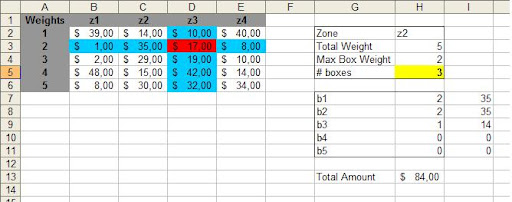excelbetter
Board Regular
- Joined
- Oct 13, 2010
- Messages
- 190
Can anyone help?
I am looking to do a "lookup" whereby I find the total cost of shipping x# of boxes via UPS. Let me see if I can complicate this a bit further.
When we ship a bunch of stuff to our customers, the order will go in several boxes. UPS charge different rates per box shipped. So, 1 box of 5 lbs is cheaper than an order of 5 lbs total broken into 2 boxes of 2 lbs and 1 box of 1 lbs. (i.e the rates and zones shown in the image below)
Therefore, I'm trying to figure out how I can have a "total order weight" and a "max weight per box" and create a formula that does 3 things:
1) Figure out how many boxes there will be on the order (i.e. total order weight / max weight per box)
2) Figure out the exact weight of each box if the total order weight was 5 lbs and the max weight per box (i.e. a fixed variable) is 2 lbs, I can logically see there will be 2 boxes of 2 lbs each and 1 box of 1 lbs.
3) Use some lookup feature to find the combined total rate of the 3 boxes above (i.e. 2 @ 2 lbs each and 1 @ 1lb).
Any thoughts on how to do this? Thanks.
NOTE: The Total Order weight in the image should read 5 lbs, not 2 lbs as shown. The max weight per box is 2 lbs.

- Show quoted text -
I am looking to do a "lookup" whereby I find the total cost of shipping x# of boxes via UPS. Let me see if I can complicate this a bit further.
When we ship a bunch of stuff to our customers, the order will go in several boxes. UPS charge different rates per box shipped. So, 1 box of 5 lbs is cheaper than an order of 5 lbs total broken into 2 boxes of 2 lbs and 1 box of 1 lbs. (i.e the rates and zones shown in the image below)
Therefore, I'm trying to figure out how I can have a "total order weight" and a "max weight per box" and create a formula that does 3 things:
1) Figure out how many boxes there will be on the order (i.e. total order weight / max weight per box)
2) Figure out the exact weight of each box if the total order weight was 5 lbs and the max weight per box (i.e. a fixed variable) is 2 lbs, I can logically see there will be 2 boxes of 2 lbs each and 1 box of 1 lbs.
3) Use some lookup feature to find the combined total rate of the 3 boxes above (i.e. 2 @ 2 lbs each and 1 @ 1lb).
Any thoughts on how to do this? Thanks.
NOTE: The Total Order weight in the image should read 5 lbs, not 2 lbs as shown. The max weight per box is 2 lbs.

- Show quoted text -
Last edited:







